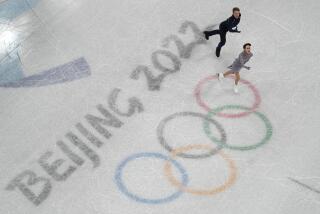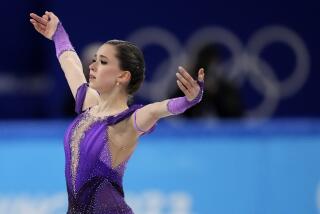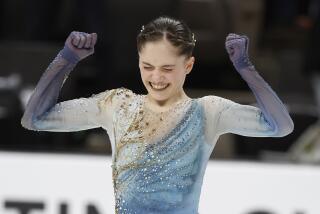Some Movement Toward Reform
- Share via
KYOTO, Japan — Figure skating took its first meaningful step toward reform Thursday, adopting a Canadian proposal to expand judging panels to 14 at international events and program a computer to randomly select nine scores that will determine competitors’ results in each phase of competitions.
But after wading through two hours of rhetoric at the end of a tedious day, few delegates at the International Skating Union Congress fully understood what they had done--and none would predict the long-term effects.
“Have they got it?” one high-ranking official said as she circulated among clusters of delegates.
Probably not. At one point, undecided whether to rank skaters by total points, average score or median mark, they considered reverting to the scoring system used a decade ago, before the One by One system was adopted to rank skaters in comparison to other skaters. After much backtracking and posturing, that was rejected and Skate Canada’s proposal was approved, 39-8, with three abstentions.
The U.S. Figure Skating Assn., whose proposal to rank skaters by a median mark was rejected, 35-15, voted against Canada’s proposal.
“Everybody agreed we should be doing something,” said Israeli delegate Judith Javor, “but at the same time, they were frightened of change. There’s no law that says change will be better.”
But change was inevitable, spurred by ISU President Ottavio Cinquanta’s declaration the sport is in crisis and must dispel the perception--and too often the reality--that results are tainted by bloc voting and deal making by judges.
It was on his recommendation that the International Olympic Committee awarded duplicate gold medals to pairs skaters Jamie Sale and David Pelletier of Canada, after improprieties in the judging of the event threatened to consume the Salt Lake City Games. And it was because he insisted the Congress chart a new course before dissolving today that debate raged through the dinner hour Thursday.
“I think the IOC shall be satisfied, because within a few months we acted,” said Cinquanta, who today was elected to a third four-year term in office. “Nobody can say the ISU under President Cinquanta has done nothing.”
Three days after approving the study of an ISU project that would overhaul the scoring and judging systems, the Congress created a transitional shelter between the methods that gave them a black eye at Salt Lake City and the ISU’s radical plan. Cinquanta said his pet project could be tested “in a very discreet manner” next February or March and launched in two years, but nervous delegates weren’t ready for that leap.
“Sometimes, it’s best to go step by step,” said Sally Anne Stapleford of Britain, chair of the influential figure skating technical committee. “It wasn’t how we calculated judges’ marks that was the problem.
“I’m not a mathematician, but if you have 14 judges and choose nine, five make the decision [as a majority]. That’s a concern. But at least the judges won’t know who’s being used. At the end, we got a result, and that was the main aim of the day, wasn’t it?”
That result was surprising, because Canada’s proposal had been overshadowed by bold initiatives from the U.S. and Australia.
The USFSA median mark plan was soundly defeated despite vigorous campaigning. Its early support vanished after Slovakia delegate Felicitas Babusikova, projecting a table of theoretical results onto a screen, claimed the method would produce unjust finishes.
The table, which also poked holes in Australia’s proposal, caught USFSA officials unprepared. Not even their withdrawal of a provision calling for the random selection of seven judges’ scores from 10-judge panels could salvage their cause.
“We would have preferred to see a more clear attempt at change,” said USFSA President Phyllis Howard. “We do think we did provide some real impetus for change. People heard our message.”
Australia’s proposal was similar to Canada’s, but its idea to drop the two high and two low scores was shunned by delegates who believed it left too much power in the hands of too few judges.
More to Read
Go beyond the scoreboard
Get the latest on L.A.'s teams in the daily Sports Report newsletter.
You may occasionally receive promotional content from the Los Angeles Times.







